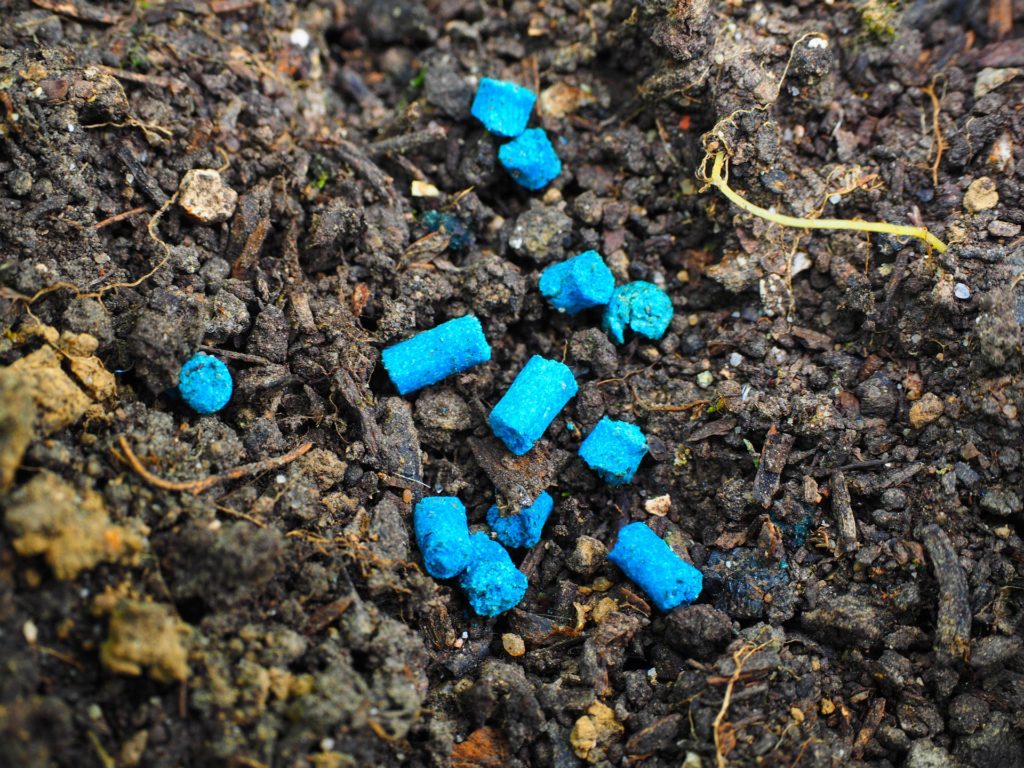Slug pellets in dogs (Toxic? + 11 symptoms)
- Veterinarian Mag.med.vet. Emin Jasarevic
- Updated: 2023-04-11
Why is slug pellet poisonous for the dog? Which substances are so harmful and what are the symptoms of poisoning? I will show you this and much more in this article. In addition, we have for this article advice from the Veterinarian Mag.med.vet. Emin Jasarevic obtained.

In case of poisoning with slug pellets should act quickly!
Why is slug pellet toxic for dogs?
The packaging of most slug pellet products states that they are not toxic to pets. This is often misleading and sometimes even wrong.
Slug pellet, as the name suggests, is designed to drive slugs out of the garden. Once they have absorbed the poison, they are doomed to death.
However, this toxin is also dangerous for your pet. If he ingests it, it is also a life-threatening emergency for him. The effect of slug pellets begins many times faster than Rat poison!
Thus show the first symptoms already 30 to 60 minutes after admission of the grain!
Which active ingredients are toxic?
1. metaldehyde
Metaldehyde is a neurotoxin derived from sulfuric acid and is contained in slug pellets. The consumption leads to Muscle cramps, Palpitations and finally to the Death.
The lethal dose of metaldehyde ranges from 0.2 g to 0.5 g per kilogram body weight, depending on the breed. In addition, its effect sets in more quickly than rat poison. Furthermore, there are no specific symptoms that point exclusively to this nerve poison. Only a test in the laboratory can provide one hundred percent clarity here.
Metaldehyde is converted in your dog's body to Acetaldehyde and thereupon to Acetic acid transformed. It does not act as a deterrent to dogs because for them it is sweetish taste. Although slug pellets must be enriched with bitter substances, this is not always the case. However, that doesn't necessarily stop your furry friend from eating the grains anyway.
2. thiodicarb and methiocarb
Thiodicarb and methiocarb are mainly used in crop protection. They are mainly found on corn, cotton and soybeans and control beetles, butterflies as well as slugs. They are considered Nerve agents and are also used against agricultural pest birds.
Dogs are affected by these substances restless and Excited. Not infrequently this is associated with painful cramps connected. Thiodicarb is formed in production by a chemical reaction of methomyl and thionyl chloride.
It was not approved by the EU Commission in 2007. In Germany, Austria and Switzerland, however, its use is not punishable.
Thiodicarb is classified as possibly carcinogenic, methiocarb only as very toxic. These two ingredients of slug pellets also cause a variety of poisoning symptoms.
3. ferric phosphate
Ferric phosphate is used in pharmaceuticals, ceramics, pesticides and slug pellets. It also appears in nature as the mineral strengite in the soil. It is produced by a chemical reaction of iron hydroxide and phosphoric acid.
Although the active ingredient is considered harmless for warm-blooded animals, one should be careful with this statement. It is difficult to dissolve in water and for smaller dogs there is also a risk of suffocation.
How can my dog get poisoned?
Most dogs that are poisoned with slug pellets eat it directly. Be it out of curiosity or any other reason. This is especially true for puppies. Due to their low weight, they also have a greater risk of poisoning.
But there are many more ways in which your protégé can ingest the poison. For example, if he simply passes through a Bed or a field has run and then licks his paws. In doing so, it may eat a grain that has gotten between its toes or pick up grains that have already dissolved.
But also, if your darling has an at the poisonous grain eats snail that died, the poison is also transferred to him. Also, make sure that when your four-legged friend goes for walks near Agricultural fields does not drink from any puddle.
Because of the large amounts of pesticides applied here, this is also a potential avenue for poisoning.
What are the symptoms?
There are no concrete symptoms that explicitly indicate slug pellet poisoning.
Therefore, the indications that point to poisoning are very diverse. Basically, the first manifestations can be seen after 30 to 60 minutes. With smaller amounts possibly a little later. Among them would be:
- Vomiting (with blood) | sometimes poisonous granules can be detected in the vomit
- Irritation of the mucous membrane of the mouth and eyes, salivation
- Irregular heartbeat, palpitations
- Falling body temperature
- Rapid breathing and heavy panting
- Restlessness and agitation
- Diarrhea
- Muscle cramps and severe tremors
- High fever
- Coma
- Unsteady gait, coordination disorders
IMPORTANT: Can't positively identify the poison, but can you rule out with certainty that your protégé ingested slug pellets? Then consider other poisons.
Rat poison is also used in attacks on dogs. Insects such as wasps, bumblebees, bees or hornets can also provide a poison injection.
In addition, they also bring in protein foreign to the body, which can cause anaphylactic shock to develop. After walks in the woods, asps vipers, meadow vipers or adder are also not to be ruled out!
What measures can I take?
1. when it has just happened
If you have observed that your pet has licked or eaten slug pellets, you must react immediately. There is no antidote against the metaldehyde contained in slug pellets.
The only remedy you can use to help is charcoal tablets. Also known as animal charcoal or medicinal charcoal. The sooner your pet is given this activated charcoal, the more effective it will be. The idea is to prevent the toxin from being absorbed into the gastrointestinal tract.
The charcoal tablets bind the toxin to themselves and it is then excreted in the feces. After administration, you must immediately consult a veterinarian.
Here you can find more information about charcoal tablets.
IMPORTANT: If you don't have an emergency supply of charcoal tablets in the house, don't bother trying to get some. Instead of taking the risk that you might be unsuccessful and lose important time, go straight to the vet.
2. if you already notice symptoms
If this happens, you can no longer take emergency medical measures. Now your dog must go to the vet as soon as possible!
During transport, it is important to keep an eye on the vital functions and to keep the patient conscious. If necessary, also resuscitate!
IMPORTANT: DO NOT induce vomiting by manipulation, such as by injecting other substances! The danger can otherwise worsen again by a lot. The airways of your weakened dog could be blocked with the vomit, creating a choking hazard. A mouth sling is also strictly forbidden!
How can you support your vet?
- If available, secure and bring a sample of the poison or poison bait.
- Vomit can also help.
- A fecal or urine sample excreted after toxin ingestion is also helpful.
- Also, during transport, pay attention to how the vital signs change over time. This will help to determine improvement or deterioration later.
Recognize early and take action!
The poisonous grain can appear in a variety of colors. Blue, red and green, it is available in many colors.
Should you discover them, then keep your furry companion away from them. If slug pellets are used in the home garden, then your pet has no business being there for the foreseeable future. The risk of poisoning is too great.
- When using slug pellets in the garden, always stow packaging out of reach of children and pets. Locked cabinet etc.
- Otherwise, completely abandon it and do not use it at all.
Frequently Asked Questions
Slug pellet is a pesticide that acts specifically against harmful slugs. It has the form of colorful, usually blue grains and may contain various poisons that can also harm dogs.
Slug pellets are toxic to dogs depending on the ingredient. In addition, there is a risk of suffocation for smaller dogs. So it's best not to use it in your own garden and make sure your dog doesn't eat slug pellets when you go for a walk.
Slugs are harmless to dogs unless they have died from slug pellets. Now, when your dog eats them, he also ingests the poisonous slug pellets. So better avoid eating slugs with your dog.
Slug pellet poisoning in dogs manifests itself in various symptoms. These include vomiting blood, trembling, fainting, fever, panting or diarrhea.
If you have activated charcoal tablets available, administer them to your dog immediately. Take him to the vet as soon as possible. Do not try to force vomiting on your dog, as this may further aggravate his condition.
Veterinarian’s Recommendation
Slug pellets are not to be trifled with!
So if you see that your pet has eaten slug pellets or he is showing symptoms of poisoning, action must be taken quickly.
For first aid, he now needs charcoal tablets as quickly as possible.
If you don't have charcoal tablets in the house, take your pet directly to the vet. This will save you time.
If you notice the symptoms and are not sure what could be the cause, then the vet should also be consulted. Besides slug pellets, rat poison or other toxic substances can also be the trigger.

I am a veterinarian and writer on animal health topics. Animals are my passion, and it is my personal goal to create medically accurate articles and videos to educate pet owners as much as possible.
Share Now:

